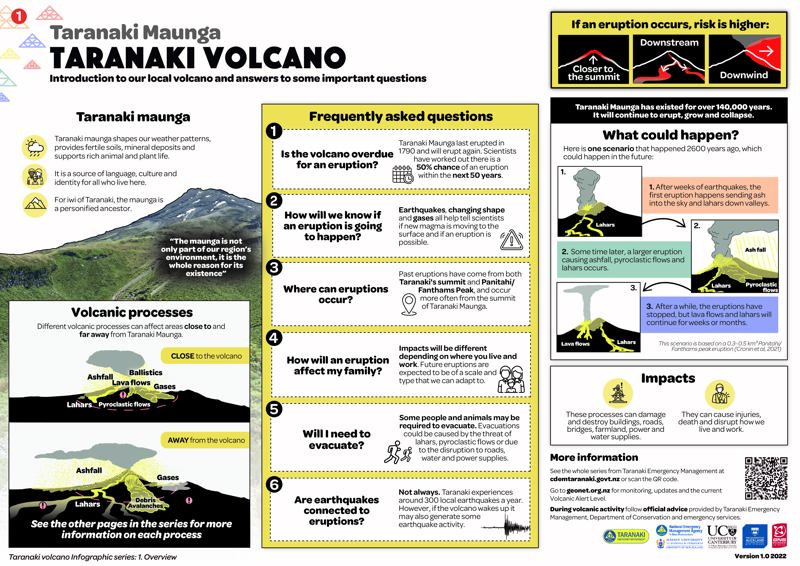A volcanic eruption of Mt Taranaki has been assessed as a moderate – very high hazard for the Taranaki region and is the top hazard for the Taranaki region. The probability of an eruption is a 20 – 50% chance in the 50 years.
Mount Taranaki or Taranaki Mounga is one of the most symmetrical volcanic cones in the world and, at 2,518 meters high, is the second-highest peak in the North Island. The Mounga is located within Te Papakura o Taranaki (Egmont National Park).
Mount Taranaki is a composite cone or strato-volcano, made up of alternating layers of volcanic ash and lava flow. Eruptions from strato-volcanoes usually occur from a central vent and commonly create lava domes and flows, lahars, floods, and sometimes major collapses. The current summit crater of Mount Taranaki contains a lava dome surrounded by ice and snow.
How to get ready for a volcanic eruption
- Stay informed. Listen to the radio and follow official advice from Emergency Management and emergency services
- Stay at home unless you are told to evacuate. Do not go into the national park area around Mount Taranaki. Avoid rivers and valleys as there may be lahars.
- Prepare your home for ashfall – see the next section below.
- Check on your neighbours and anyone who might need your help.
- Before ash fall starts, go home, if possible, to avoid driving or walking during ash fall.
- Bring pets inside and move livestock into closed shelters. Make sure that animals have supplementary feed and access to clean drinking water.
- Close all windows and doors, shut down heat pumps, air conditioning units, and seal any ventilation intakes.
- Set up a single-entry point for your house. Place damp towels at the threshold to prevent ash being tracked indoors.
- Cover vehicles, machinery, spa pools and sensitive electronics indoors and outdoors. Do not remove covers until the indoor environment is completely ash free. Ash can corrode metal surfaces and cause abrasion damage to windscreens and paintwork.
- Disconnect drainpipes/downspouts from gutters to stop drains clogging. If you use a rainwater collection system for your water supply, disconnect the tank.
- Check on your neighbours and anyone who might need your help.
- Listen to the radio for updates. Follow official advice from Emergency Management and emergency services
- Stay indoors. Volcanic ash is a health hazard, especially if you have respiratory difficulties such as asthma or bronchitis.
- Do not attempt to clear ash from your roof while ash is falling.
- Keep pets indoors.
- Do not drive when there is ash on the road.
- If you must go outside, use protective gear such as masks and goggles and keep as much of your skin covered as possible; wear eyeglasses, not contact lenses, as these can cause corneal abrasions.
- Continue to follow official advice from emergency management and emergency services. Stay out of restricted areas.
- If you have been evacuated, do not return home until told it is safe to do so by an official source such as emergency management or emergency services.
- Keep children indoors and discourage play in ash.
- Keep animals indoors until ash is cleaned up or washed away.
- If your property is damaged, take photos for insurance purposes. If you rent, contact your landlord and contents insurance company as soon as possible.
- It is important to clean up ash promptly, as it is a health hazard and can cause damage to buildings and machinery.
- When cleaning up, follow advice and instructions from your local council and Emergency Management Group. Be aware that:
- ash clean-up is physically demanding and time-consuming
- in bulk, ash is much heavier than people often expect
- repeated cleaning may be necessary
- water restrictions are likely after ash fall.
- Use water very sparingly to avoid depleting water supplies.
- Wear protective clothing that covers your arms and legs, sturdy footwear, a properly fitted P2 or N95 mask, and goggles.
- If you have a visual impairment, wear eyeglasses. Do not wear contact lenses because trapped ash can cause corneal abrasions.
- Clean up any ash indoors to protect indoor air quality.
- Ash is much more abrasive than ordinary house dust. The best cleaning methods to prevent scratching damage are vacuuming and rinsing. Use water sparingly.
- If possible, clean electronic equipment with an air duster to avoid scratching delicate surfaces.
- Wait until ash has stopped falling before starting any outdoor clean-up. Remove ash before rainfall if possible.
- When cleaning up ash, use shovels first, then brooms to reduce the amount of ash particles in the air. Do not wet and rub painted surfaces as ash is abrasive – use a brush instead.
- It can help to dampen ash when cleaning up but use water very sparingly. There will be water shortages, and wet ash can become a heavy glue-like material that can collapse roofs and other structures.
- Follow official instructions about ash collection and storage from your local council and Emergency Management Group.
- Do not dispose of ash into drains as it can cause blockages and be difficult to remove.
- More advice about cleaning up ash is available on the United States Geological Survey (USGS)

Volcanic Infographic Posters
These infographics show what might happen in an eruption on Taranaki Mounga. They are designed to give a simple and accessible overview of common volcanic processes and what to do in an eruption.

